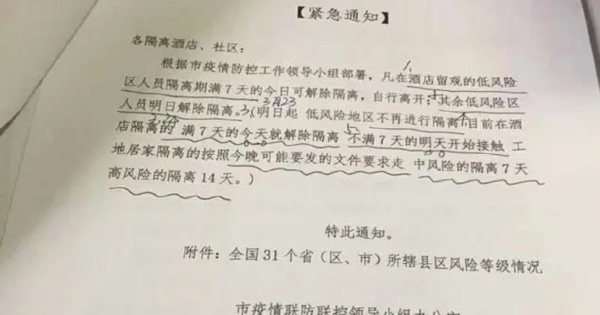A Chinese government committee relaxed its quarantine policy in the Tibetan capital Lhasa this week, in the midst of Beijing’s campaign to repair China’s economy and reputation around the world in the wake of the global COVID-19 outbreak.
Official notice
The official notice from the Lhasa City Epidemic Prevention and Control Leading Committee, dated March 23, says that people from “low-risk” areas who are quarantined in hotels or elsewhere can move outside if they have already been in quarantine for a week.
The notice, a copy of which was posted on Chinese social media, also says that while people arriving from “low-risk” places may not have to stay in quarantine, people arriving from medium- and high-risk places should be quarantined for seven and 14 days respectively.

An image of the announcement.
Although the notice does not say how the categorization of the risks will be done, the New York Times has reported that the Chinese authorities, as part of its overall coronavirus surveillance plan, will be using a controversial, color-coded QR scan system that depicts an individual’s health status based on their travel history, place of origin, etc.
According to the New York Times analysis, the software “appears to share information with the police, setting a template for new forms of automated social control that could persist long after the epidemic subsides.”
Tibet, a historically independent country that China annexed in 1959 and continues to rule over with an iron fist. is already one of the most controlled and least free places on Earth.
Sensitive anniversaries
The coronavirus outbreak coincided with the most sensitive time on the calendar in Tibet. The month of March includes the anniversaries of the 1959 Tibetan Uprising against Chinese rule, the Dalai Lama’s escape into exile that year and the mass protests that spread across the Tibetan Plateau in 2008.
Since the 2008 protests, the Chinese government has closed the Tibet Autonomous Region—which spans much of western and central Tibet— to foreigners for at least one month every year around this time. In 2019, the region was closed from Jan. 30 until April 1.
Access to Tibet
Even when there are no sensitive anniversaries on the calendar, China severely restricts foreigners’ access to Tibet.
In late 2018, the US Congress passed the Reciprocal Access to Tibet Act, which forbids entry to the US by the Chinese officials directly responsible for keeping American journalists, diplomats and ordinary citizens out of Tibet.
The State Department is soon expected to release a report on the status of access to Tibet, including identifying Chinese officials responsible for denying permission for Americans.
Endangering Tibetans to boost Chinese business?
In eastern Tibet, local Tibetans told Radio Free Asia that authorities in the Kardze (Chinese: Ganzi) Tibetan Autonomous Prefecture, located in the province of Sichuan, are reopening tourist sites there, causing them to fear a second wave of COVID-19.
The RFA report quotes a Tibetan living in Dartsedo (Ch: Kangding) as saying, “We are still scared of the virus. We have self-quarantined and hardly go out, and if we do, we wear facemasks. But now that they are reopening the tourist sites in Kardze, hundreds of [Han] Chinese visitors are coming into our area every day. It is very concerning because just one of those tourists can start the spread the coronavirus here again.”
English Translation of the Lhasa City Notice
The International Campaign for Tibet translated into English the official notice from the Lhasa City Epidemic Prevention and Control Leading Committee:
Urgent notice
To all hotels and communities used for quarantine:
In accordance with the City Epidemic Prevention and Control Leading Committee’s decision, people from low risk areas who are in quarantine in hotels can be out of isolation from today and move outside if they have already spent a week in isolation till date. Those who are in quarantine outside of hotels having arrived from low risk areas can be out of isolation tomorrow onward. Beginning from tomorrow, people from low risk areas will not be put under quarantine. Those who have been in quarantine for 7 days in hotels can be out of isolation tomorrow onward. Those in quarantine at work place and at home should follow the notice that will be sent tonight. Those arriving from medium risk areas should be in quarantine for 7 days and those from high risk areas should be in quarantine for 14 days.
Copy of notice to be sent to 31 provinces(including the four provincial-level autonomous regions and the four provincial-level municipalities)after assessing risk situation.
City Epidemic Prevention and Control Leading Committee
March 23, 2020.

